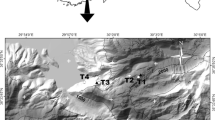Abstract
Analysis of the branch area/stem area ratio of Scots pine growing in different climatic conditions in Europe and Siberia indicates that the branch area supported by a stem increases in warmer and drier conditions. The ratio was significantly correlated with several climatic variables, especially with potential evapotranspiration (E p). The ratio was negatively correlated with stand density (d s). A regression model combining E p and d s accounted for 85% of the total variation. These trends are believed to reflect hydraulic segmentation of trees and may represent a strategy to avoid cavitation in the tree, especially in the branches.
Similar content being viewed by others
References
Albrektson A (1988) Sapwood basal area and needle mass of Sots pine (Pinus sylvestris L.) trees in central Sweden. Forestry 57: 35–43
Baas P (1986) Ecological patterns in xylem anatomy. In: Givinish TJ (ed) On the economy of plant form and function. Cambridge University Press, Cambridge, pp 327–349
Baas P, Werker E, Fahn A (1983) Some ecological trends in vessel characters. IAWA Bull 4:2–3: 141–159
Barrantes O, Gracia CA (1989) Estimation del area foliar a partir de la superficic de albura en Pinus sylvestris. Options Méditerranéens-Séric séminaires 3: 53–56
Berninger F, Nikinmaa E (1994) Within tree and between site variation in the foliage area-sapwood are relationships in Scots pine stands in different climatic condictions. Can. J. For. Res. 24: 2263–2268
Carlquist S (1988) Comparative wood anatomy: systematic, ecological and evolutionary aspects of dicotyledon wood. Springer, Berlin Heidelberg New York
Echols RH (1958) Variation in tracheid length and wood density in geographic races of Scots pine (Bulletin 64). School of Forestry, Yale University, New Haven
Ewers FW (1985) Xylem structure and water conductivity in conifer trees, dicot trees and lianas. International Association of Wood Anatomists Bull 6: 309–317
Ewers FW, Zimmermann MH (1984) The hydraulic architecture of balsam fir (Abies balsamea). Physiol Plant 60: 453–458
Hari P, Kaipiainen L, Korpilahti E, Mäkelä A, Nilsson T, Oker-Blom P, Ross J, Salminen R (1985) Structure radiation and photosynthetic production in coniferous stands. Univ Helsinki Dep Silvicult Res Notes 54: 1–233
Hari P, Heikinheimo P, Mäkelä A, Kaipiainen L, Korpilahti E, Salmela E (1986) Trees as a water transport system. Silva Fenn 20: 205–210
Hees AFM van, Bartelink H (1993) Needle area relationships in Scots pine in the Netherlands. For Ecol Manage 58: 19–31
Huber B (1928) Weitere quantitative Untersuchungen über das Wasserleitungssystem der Pflanzen. Jahrb Wissensch Bot. 67: 877–959
Jacobs MR (1939) A study of the effect of wind sway on trees (Bulletin 26). Australian Commonwealth Forestry Bureau, Canberra
Jacobs MR (1954) The effect of wind sway on the form and development of Pinus radiata D. Don. Aust J Bot 2: 35–51
Kaipiainen L, Hari P (1985) Cosistencies in the structure in Scots pine. In: Tigerstedt PMA, Puttonen P, Koski V (eds) Crop physiology of forest trees. Helsinki University Press, Helsinki, pp 32–37
Larson PR (1963) Stem form development of forest trees. For Sci Monogr 5: 1–41
Mäkelä A (1986) Implications of the pipe model theory on dry matter partitioning and height growth of trees. J Theor Biol 123: 103–120
Müller MJ (1982) Selected climatic data for a global set of standard stations for vegetation science. Junk, The Hague
Nikinmaa E (1992) Analysis of the growth of Scots pine: matching the structure with the function. Acta For Fenn 235: 1–68
Oever L van den, Baas P, Zandee M (1981) Comparative wood anatomy of Symplocos and latitude and altitude of provenance. IAWA Bull 2: 3–24
Richter JP (1970) The notebooks of Leonardo da Vinci (1452–1592), compiled and edited from the original manuscripts. Dover, New York
Rosenberg NJ, Blad BL, Verma SB (1983) Microclimate: the biological environment. Wiley, New York
Schulze-Dewitz G (1968) Einfluss der Vegetationszeit auf einige Strukturmerkmale bei Kiefernholz. Holzindustrie 21: 55–58
Sellin A (1993) Resistance to water flow in xylem of Picea abies (L.) Karst. trees growing under contrasting light conditions. Trees 7: 220–226
Shelburne V, Hedden R, Allen R (1993) The effects of site, stand density, and sapwod permeability on the relationship between leaf area and sapwood area in loblolly pine (Pinus taeda). For Ecol Manage 58: 193–209
Shinozaki K, Yoda K, Hozumi, Kira T (1964) A quantitative analysis of plant form — the pipe model theory. I. Basic analyses. Jpn J Ecol 14: 97–105
Thornthwaite CW (1948) An approach toward a rational classification of climate. Geogr Rev 38: 55–94
Tyree MT, Flanagan LB, Adamson N (1987) Response of trees to drought. In: Hutchinson TC, Meema KM (eds) Effects of atmospheric pollutants on forests, wetlands and agricultural ecosystems (NATO ASI series vol G16), Springer, Berlin Heidelberg New York, pp 201–216
Valinger E (1992) Effects of wind sway in stem form and crown development of Scots pine (Pinus sylvestris L.). Aust For 55: 15–21
Valentine HT (1985) Tree-growth models: derivations employing the pipe model theory. J Theor Biol 117: 579–584
Whitehead D (1978) The estimation of foliage area in Scots pine. Forestry 51: 137–149
Zhang SY, Baas P, Zandee M (1992) Wood structure of the Rosaceae in relation to ecology, habitat and phenology. International Association of Wood Anatomists Bull 13: 307–349
Zimmermann MH (1983) Xylem structure and the ascent of sap. Springer, Berlin Heidelberg New York
Author information
Authors and Affiliations
Rights and permissions
About this article
Cite this article
Berninger, F., Nikinmaa, E., Hari, P. et al. Evaporative demand determines branchiness of Scots pine. Oecologia 102, 164–168 (1995). https://doi.org/10.1007/BF00333247
Received:
Accepted:
Issue Date:
DOI: https://doi.org/10.1007/BF00333247




